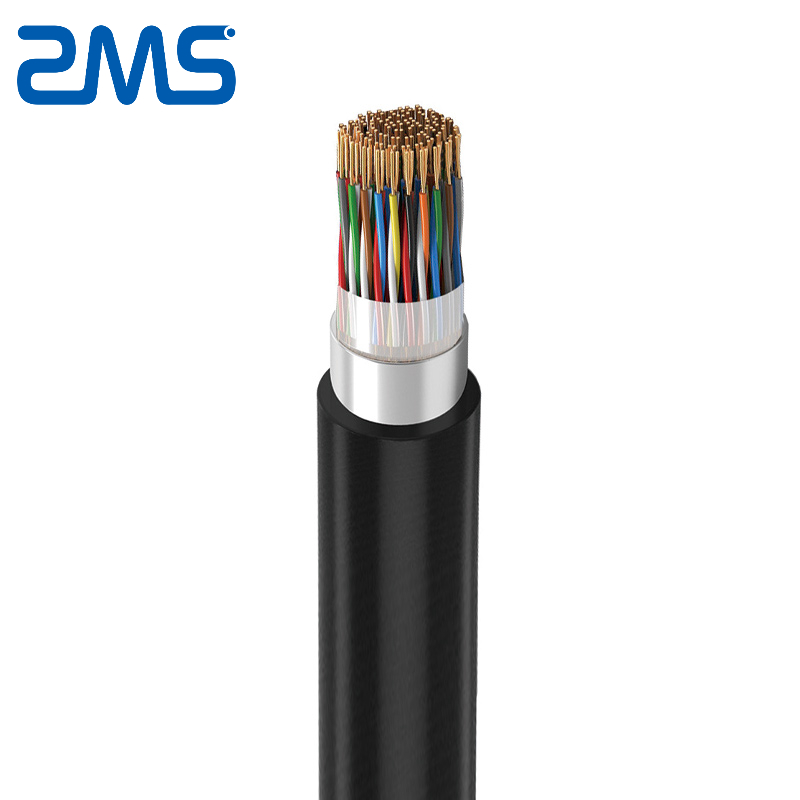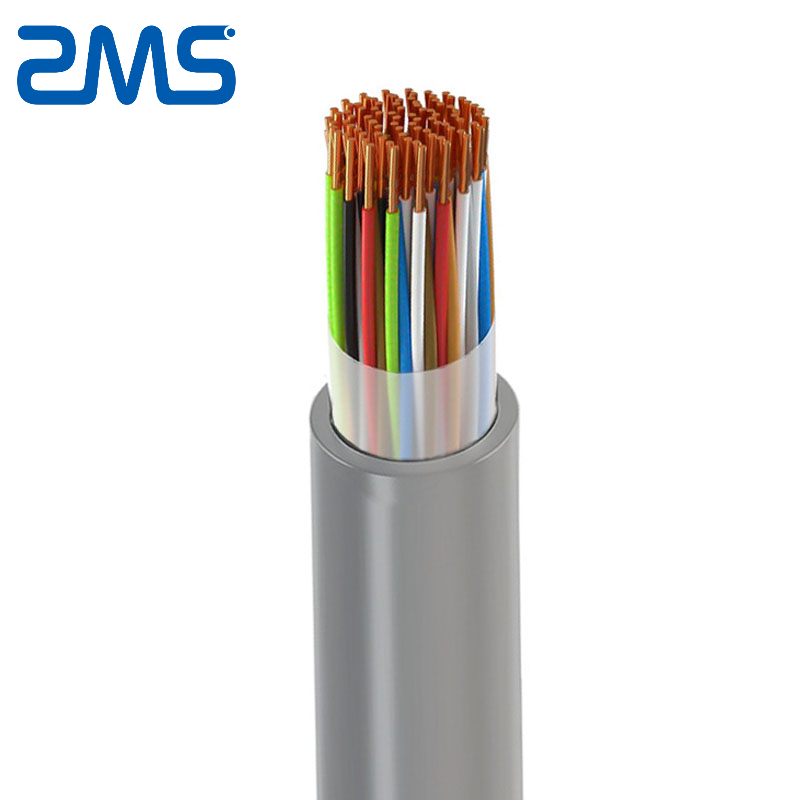Communication and Telecommunication Cable
Communications cables are cables that carry telephone, telegraph, fax documents, television and radio programs, data, and other electrical signals. It is formed by twisting more than one pair of mutually insulated wires. Compared with overhead wires, communication cables have the advantages of high communication capacity, high transmission stability, good confidentiality, and less influence by natural conditions and external interference.
ZMS’s communication and telecommunication cables include a wide range of applications. They include fiber optic cables, coaxial cables, city communication cables, submarine communication cables, etc. for voice, data, and signal transmission.

Types of Communication Cables
HYA Outdoor Communication Cable
HYA is a copper core solid polyolefin insulated moisture barrier polyethylene sheathed inter-municipal communication cable mainly used for transmitting audio, analog signals of 150kHZ and below, and digital signals of 2048kbit/s and below. Under certain conditions, it can also transmit digital signals above 2048kbit/s. Applicable to the city, suburbs, and local areas of the overhead or pipe laying lines, can also be buried directly.
- Bare copper conductor, single-wire
- Core insulation of PE (2Y)
- Core identification of quads marked
with black rings - 4 cores twisted to a star quad
- 5-star quads are stranded to subunits, each with 5 or 10 sub-units stranded to main units and the sub or main units to the cable core.
- Core wrapping with several plastic tapes
- Outer sheath, as a laminated sheath (L)2Y, PE-coated aluminum tape spliced with
PE (2Y) sheath - Sheath color: black
- Sheath marking continuously with a telephone receiver, meter marking in white color.
HYV Indoor Communication Cable
HYV communication cable is copper core polyolefin insulated PVC sheathed municipal communication cable. It is used for pipe laying, overhead, etc. Installation cables are preferably used as telephone cables in telephone stations and sub-extensions, in dry and damp premises, and in or under plaster, in the open air for fixed installation. Telephone installation cables are not allowed for purposes of high current and power installation.
CE = Product conforms with Low-Voltage Directive 2014/35/EU.
- Bare copper conductor, single-wire
- Core insulation of PVC, compound type YI1 acc. to DIN VDE 0207-4
- Core and star-quad identification acc. to DIN VDE 0815
- The cores to a quad and each 5 quads to a unit and several units are stranded in layer
- Foil wrapping
- Outer sheath of PVC, flame retardant, compound type YM1 acc. to DIN VDE 0207-5
- Sheath colour: grey
Laying Method of Communication and Telecommunication Cables
Communication cable: It is a communication line composed of multiple mutually insulated wires or conductors twisted into a cable core and an outer sheath that protects the cable core from moisture and mechanical damage. In places where the environment is particularly harsh, if necessary, the outside of the communication cable sheath can also be installed outside the protective layer.
Communication cable has a variety of laying methods such as overhead, direct burial, pipeline, and underwater. The structure is divided into symmetrical, coaxial, and integrated cables. The function is divided into the field and permanent cable (underground, submarine cable). Communication cable transmission band is wider, communication capacity is larger, subject to external interference is small, but not easy to repair. It can transmit telephone, telegraph, data, images, etc.
Classification of Communication Cables by Usage
The use of communication cables and the scope of use can be divided into six major series of products
That is, urban communication cables (including paper-insulated city telephone cable, polyolefin-insulated polyolefin-sheathed city telephone cable)
Long distance symmetrical cable (including paper insulated high and low-frequency long distance symmetrical cable, copper core foam polyethylene high and low-frequency long distance symmetrical cable, and digital transmission long distance symmetrical cable)
Coaxial cables (including small coaxial cables, medium coaxial, and tiny coaxial cables)
Submarine communication cables (including symmetrical submarine and coaxial submarine cables)
Fiber optic cables (including traditional cable type, ribbon array type, and skeleton type three), RF cables (including symmetrical RF and coaxial RF)
Differences between Communication Cables and Other Cables
Fiber optic cable is a new generation of transmission media, compared with copper media, fiber optic both in terms of security, reliability, and network performance has been greatly improved.
In addition, the bandwidth of fiber optic transmission greatly exceeds that of copper cable, and its support of the maximum connection distance of more than two kilometers is the inevitable choice for the formation of large-scale networks.
Because fiber optic cable has the advantages of good anti-electromagnetic interference, confidentiality, speed, transmission capacity, etc., it is also more expensive and rarely used in domestic applications.
Currently, there are two different types of fiber optics, single-mode fiber and multimode fiber (the so-called “mode” refers to a certain angle into the fiber bundle of light).
Multimode fiber is generally used to connect networks in the same office building or in relative proximity to each other.
Single-mode fiber, on the other hand, delivers higher quality data over longer distances and is often used to connect networks between office buildings or in more geographically dispersed areas.
If you use fiber optic cable as a network transmission medium, you also need to add optical transceivers and other equipment, so the cost investment is greater, and in general, applications are less used.
Twisted pair is a flexible communication cable containing pairs of insulated copper wires. It is characterized by its low price, so it is widely used, such as our common telephone lines, etc.
According to the maximum transmission rate, twisted pair cables can be divided into Category 3, Category 5, and Super Category 5.
Category 3 twisted-pair cable has a rate of 10mb/s, Category 5 can reach 100mb/s, while Super Category 5 is up to 155mb/s or more, which can be suitable for future multimedia data transmission needs, so Category 5 or even Super Category 5 twisted-pair cable is recommended.
Twisted pair cable can also be divided into shielded twisted pair (stp) and unshielded twisted pair (UTP). stp twisted pair although the rate is lower (only 4MB / s), the anti-interference than UTP twisted pair strong, so the price is also much more expensive, now this type of twisted pair cable cheap a few dollars a meter, the expensive well may be more than ten dollars to buy a meter. In contrast, UTP twisted-pair cable price is generally in a meter of a dollar or so, relatively inexpensive.
In addition, the common 10m and 100m unshielded twisted-pair cable popularly known as 10base-t and 100base-t, we can often see in the market. And twisted pair cable supporting the use of rj45 crystal head, used to make twisted pair cable and network card rj45 interface between the connector, its quality is directly related to the stability of the entire network, can not be ignored.
Coaxial cable is more familiar to many friends of a class of transmission media, it is a layer of insulated wire wrapped around the central copper conductor of the cable line. Its biggest feature is good anti-interference ability, stable transmission data, and also cheap, so it was once widely used, such as closed-circuit television lines.
However, coaxial cables used to be used more often, mainly because coaxial cables make up a bus structured network at a lower cost, but damage to a single cable can lead to paralysis of the entire network and maintenance is difficult, which is its biggest drawback.
Coaxial cables for Ethernet applications are mainly divided into two types: coaxial cable (10base5) and fine coaxial cable (10base2). Nowadays, coaxial cables are not used much, but there is still a market for fine coaxial cables. The fine coaxial cable line is generally sold in the market for a few dollars a meter, not too expensive.
In addition, the coaxial cable is used to connect with the BNC head, the coaxial cable sold in the market is generally connected with the BNC head finished products, which you can directly choose.
Service of ZMS Company
Over Productions Service: ZMS has a wide range of cable and conductor products for you to choose from. We will provide caring services and professional project solutions for everyone who needs them.
Quality Certification Services: ZMS cable products are manufactured according to GB, IEC, BS, NFC, ASTM, DIN, and other international standards. Our technical team can customize cable products that meet your requirements according to your needs.
Profession Customer Service: ZMS provides free professional consulting services to provide you with one-stop project solution services and rapid product delivery solutions.
Delivery And Shipping Services: While we at ZMS provide high-quality cables, we also provide good delivery solutions. While ensuring the safe delivery of products, we provide the best packaging and transportation solutions, greatly reducing customers’ transportation costs.
Packaging of ZMS: ZMS cable packaging is provided in the form of wooden reels, corrugated boxes, and coils. The cable ends are sealed with BOPP self-adhesive tape and a non-hygroscopic sealing cap to protect the cable ends from moisture. We can print the required marks on the outside of the barrel with waterproof material according to customer requirements.



